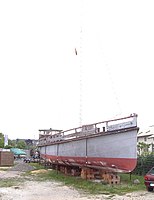Möve (ship, 1877)
|
The seagull , raised on the Hafenstrasse Konstanz
|
||||||||||||||||
|
||||||||||||||||
|
||||||||||||||||
|
||||||||||||||||
The Möve is a former cargo ship, goods tugboat and later a work ship on Lake Constance . Due to its unusually long use as a ramming ship, it was preserved and is today probably the last representative of this type of cargo ship on Lake Constance and the oldest surviving Lake Constance ship with a steel hull.
history
Before the Stahringen – Friedrichshafen and Friedrichshafen – Lindau railway lines went into operation , numerous towns on the northern shore of Lake Constance were supplied with goods by ships. For a long time this was done with Lädinen and Segmer. With the advent of steam shipping on Lake Constance, goods were transported by steamers, which initially led to violent conflicts between the boat guilds.
With the increasing number of passengers and freight, the capacity of the steamers was no longer sufficient. Therefore, from the middle of the 19th century, goods tugboats with sails were built. These cargo sailors had an iron hull, could be sailed in favorable wind conditions and were otherwise towed by the scheduled ships. The goods tugs are the successors of the Lädinen and were in use until the First World War . Then they were displaced by the railway lines around Lake Constance and the emerging truck traffic .
The Möve was built in 1877 by order of the Baden State Railways as a sailed goods tugboat and used from the home port of Constance to transport coal and grain as well as cotton , which were processed in the Constance company Stromeyer and Macaire'schen indigo dyeing on the Dominican island . It was not until 1919 that a diesel engine was installed and the sails removed. In 1920 the ship was taken over by the Deutsche Reichsbahn and used as a working and ramming ship. As such, numerous stakes and navigation marks were set by the Möve between 1920 and 2005 . In addition, there were missions for repairs, expansions and modernizations at landing sites and ports, one of the first major missions of the Möve was the electrification of the port of Meersburg in 1922 .
After 85 years of service as a work ship, the then 128-year-old Möve was replaced by the Friedrichshafen and decommissioned in the port of Constance. Its value as the last representative of the Baden goods tugboats was recognized in 2006 when the Möve was placed under monument protection. But the spent ship was always at risk; water seeping into the hull had to be pumped out constantly so that the ship would not sink. In 2009, the old cargo glider was lifted out of the water with the help of a heavy-duty crane, which was located in the port area for the installation of a new pedestrian bridge, and docked on land. In addition to important conservation measures and condition examinations, a sailing mast was installed again and the ship was exhibited in Hafenstrasse. In addition to being used as a showpiece, various concepts also aimed to attract investors for floating use. Since June 2013 there has been a private association dedicated to preserving the ship.
Web links
- Historic ship on land ( Memento from November 13, 2012 in the Internet Archive ), press release from BSB from October 1, 2009 (PDF; 31 kB)
- General plan of the Möve ( Memento of November 13, 2012 in the Internet Archive ) at bsb.de (PDF; 952 kB)
- Work ship Möve at Bodenseeschifffahrt.de
- Ships on Lake Constance as cultural monuments BSB press release from June 4, 2014 (PDF; 289 kB)
- MÖVE Association for the Rescue of the Oldest Lake Constance Ship EV side of the association for the preservation of the ship

